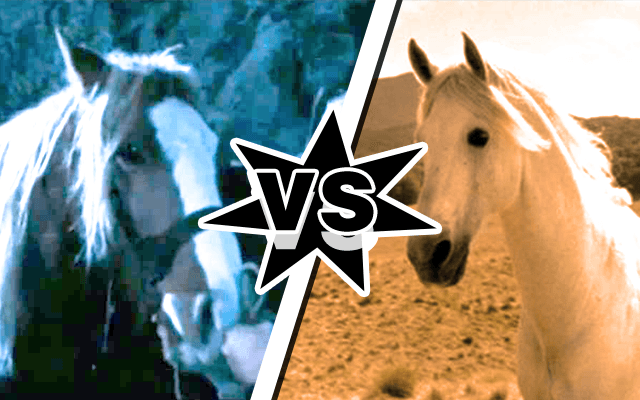Here we have our two contestants for this week’s match, the first in SFF Equines history (but not, perhaps, the last): on this side the tall, white, shining, magical, beautiful king of stallions who deigns to carry the great Wizard; and over on that side, the short, brown, fuzzy, unromantic, pretty definitely not-a-stallion who is not asked whether he wants to carry the Fellowship’s baggage (but as far as Sam can determine, he’s willing).
A serious mismatch, you say?
That, I reply, remains to be seen.
Before we get down to the one-on-one, let’s clarify that a pony is. Just about everybody gets the concept of horse, more or less: four legs, hooves, mane and tail, long neck, long head, eats grass, one end kicks, the other bites, you sit in the middle or you hitch it up to a cart and drive it. The size varies, and sometimes can be very big, especially if it’s a Fantasy Stallion(tm), but it’s always big enough for the standard (male)(Western)(very probably white unless he exists in a different universe where a Khal can be named Drogo, not to be confused with Frodo’s very respectable Hobbit father) human to ride.
So what’s a pony? It is not, contrary to all too popular belief, a baby horse. A baby horse is called a foal or a colt, though a colt is actually, technically, a male baby horse. A female baby horse is a filly.
A pony can be quite small and still be a fully grown animal. In fact the main distinction between horse and pony is height. A pony comes in at or below the standard measure of 14.2 hands at the withers, which at four inches per hand equals 58 inches. A horse comes in above that height.
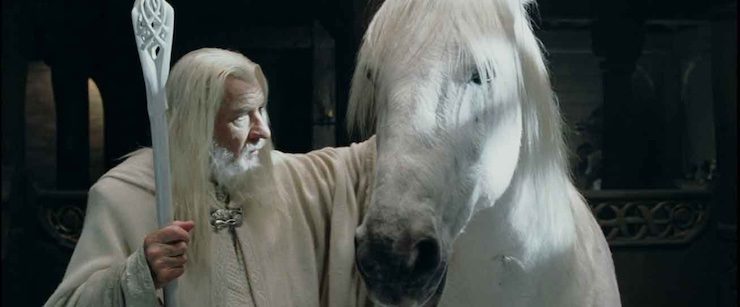
But! because horse lore can never be that simple, there are horses below 14.2 and ponies (not excessively but still) above it. That’s where you get into physical characteristics. Both horses and ponies are the same subspecies of equid, but pony breeds tend more toward shorter, thicker, and furrier, with extra helpings of mane and tail, and extra coat, especially in winter. They may also have smaller heads than the average horse, and adorable little bitty ears, though that is not a given.
Horses would generally be more lightly built, leggier, with less hair—but you still get Icelandic horses, Mongolian horses, and Fjord horses, all of whom are short, thickset, and furry. So it varies. And some breeds of horse run a gamut from pony-sized to well up in the horse range, including the Arabian; whereas you can get Connemara ponies over 15 hands, and the upper end of the Welsh pony continuum, the Welsh Cob, which gets up over 15 hands as well.
So it all depends.
What it comes down to really is the fact that the horse (or pony) can vary widely in size, and when you get way down to the Mini, that’s called a horse, though it’s much smaller than the pony (top range being 36 inches). The lay person may just want to ask a horse person whether this equine is considered a pony or a horse, and take it from there.
Fortunately for that lay person’s sanity, there really is no ambiguity about the difference between Shadowfax and good old Bill. Shadowfax in my mind’s eye presents as a particularly lovely English Thoroughbred. In the films he was played by an Andalusian (the gorgeous often-white or technically grey horse of Spain with the long, long hair—but not quite like pony hair, it’s finer and flowier). He’s tall and clean-limbed and proud, says Tolkien of the horses of Rohan in general, and he’s long-lived and has machinelike stamina and understands the speech of Men. And, Tolkien adds, he tolerates no training or handling until his One True Person arrives, that being Gandalf, but once he’s consented to let the Wizard train him, he makes certain sure the person (or Hobbit) allowed on his back will never be lost or thrown unless he actually throws himself off.
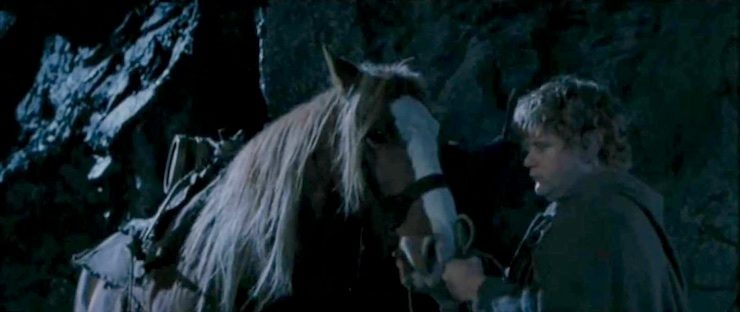
That’s a lot of horse, and a lot of self-determination. Against that we have Bill, who is small enough to be ridden comfortably by a person between three and four feet tall, so he’s probably between twelve and thirteen hands. He’s a rescue with a past, having been starved and abused by the wicked Bill Ferny, and is sold as a pack horse. He has no say in the matter, and offers no objection. When the Fellowship reaches the back door of Moria, he has to be turned loose (to Sam’s great grief) and left to survive as he can, if he can escape the Watcher in the Water.
Which we know he does, because we’re told he turns up back in Bree, and Barliman puts him to work. Eventually he finds his Sam again, and that’s Bill’s happy ending. Better yet, he gets his revenge on Bill Ferny at the Brandywine Bridge during the Scouring of the Shire, and he’s Sam’s mount when Frodo and company ride to the Grey Havens.
Shadowfax meanwhile carries Gandalf nobly through the end of the War of the Ring, and then takes him to the Havens, but it’s not clear whether he’s loaded on the grey ship for the journey to Valinor. Bill gets to go home with Sam. Shadowfax may or may not get his happy ending. Like Elrond and Arwen, he may have been parted from his loved one forever.
So that’s the first possible win: Bill gets to keep his person. Shadowfax might not. If he is left behind, he gets to go back to being King of the Mearas, which involves running free and making more Mearas, but in terms of emotional life, he’s suffered a terrible loss.
(Then again, if he does make it to Valinor, I’m sure the horses there will welcome a good outcross.) (Ooo, fanfic prompt.)
Even if Bill does get the better end of the keeping-one’s-person deal, Shadowfax has all the advantages in size, speed, and even endurance, doesn’t he? Size and speed are definite wins for Shadowfax, but for sheer blunt sticktoitiveness, there’s a lot to be said for a pony. He won’t be spectacular, he won’t be fast, but he can go on and on and on, and when it comes to living off the land, he’s the clear winner.
Shadowfax appears to live on air and wizardry, but when he’s on his own, he most probably has to eat like a normal horse. That means lots of fiber and some protein and minerals—extra protein for those extra stallion muscles—and that means plenty of good grass or other forage, and grain if he has human help. Because of his size, even if he’s an easy keeper, he’ll need quite a few pounds of fodder a day in order to keep weight and condition, plus he’ll need water to keep it all moving down that one-way street called the equine digestive system.
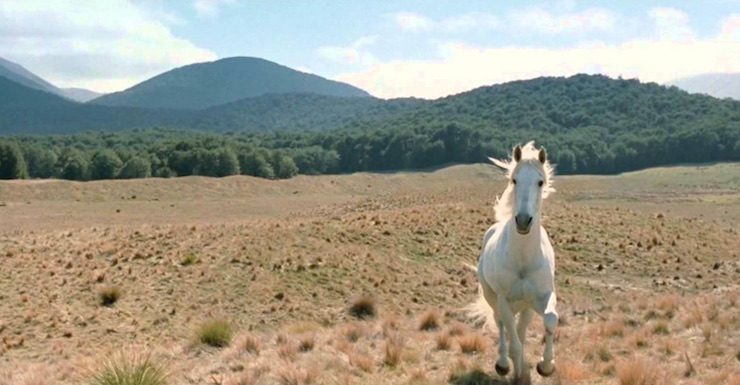
Bill has the same basic needs, but his smaller body means he can survive on a much smaller amount of feed and water. Pony metabolism tends to be much more efficient than horse metabolism, to the point that in feeding ponies, modern horsekeepers have to be very careful not to overfeed and founder their charges. That includes not just hay and concentrates but pasturage. A pony on rich grass blows up horribly fast. He’ll do much better on smaller quantities of poorer forage.
Shadowfax may need magical help to survive the terrain between Rivendell and Moria in winter cold and hard weather without starving to death, but Bill can live off the country and arrive back at Bree both alive and able to recover from the weight loss he’s suffered from living wild in winter. Tough terrain breeds tough equines, and smaller size allows the animal to make better use of the resources available. An extreme example of this would be the Shetland Isles, whose ponies (and dogs) are famously small, sturdy, and furry.
Pound for pound, too, a pony can be stronger than a horse. Shetlands can carry a grown man with ease, though his feet may drag on the ground. Horses will lose weight-bearing capability as they get larger; a very large horse is challenged enough to carry his own weight around without also carrying a heavy rider. A really big horse is not what you want to carry your very heavy rider, especially if he’s in armor. You want a cob, a stocky, sturdily built animal in the mid rage between pony and horse—14.2 to 15.2 hands. The Welsh Cob is a great example, as is the Lipizzaner. Forlong the Fat, in my head, is riding a largeish Welsh Cob, and the Cob is rocking it.
Shadowfax is quite happy to carry Gandalf, who according to the Eagle is “light as a feather,” and who is not wearing armor or carrying a lot of extra baggage. When that baggage includes a young Hobbit, he’s still not too challenged, since Pippin probably weighs a lot less by that time than he did when he left Hobbiton, and he’s likewise not wearing armor or carrying a heavy pack.
Now Bill at somewhat shy of thirteen hands may not be carrying an armed human or Wizard to battle, but if he’s serving as a packhorse for nine foot travelers, he’s probably got a significant load on his initially bony back. And he’s managing it quite well and even gaining weight as he goes on, just from being able to graze along the way. Not to mention they stop to sleep, and while they’re sleeping, Bill is hoovering up the available forage and immediately converting it to body mass and energy.
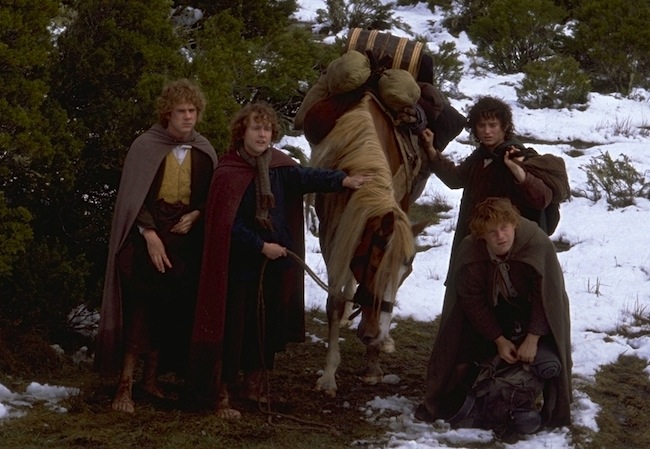
All right, so Bill is holding his own here, but what about a literal cage match? Shadowfax has a major size advantage, right? And can pound Bill to a pulp. Right? Especially since Shadowfax is a stallion, ergo testosterone, ergo more muscle mass, ergo stronger.
Well. Maybe. Also aggression, so he’ll have no compunction about ripping Bill’s throat out.
Except Bill has one thing, or maybe one and a half, that helps him manage better than you might think. He’s small, and he’s agile. While Shadowfax is still getting all that real estate up into the air for the rear and strike, Bill has skipped underneath, whipped around, and planted two good, if small, back hooves right where the future foals of the Mearas reside. Then he scampers out of there before the whole screaming mass comes toppling down.
Or if he decides to spare the potential offspring, there’s still the duck-and-bolt, and the hamstring-rip, and the hard kick to the hind cannon that does the big guy in permanently. Bill is quite a good kicker, as his namesake Bill Ferny can testify.
You see, Bill is smart. So is Shadowfax, and horses can be very smart indeed. But ponies have their very own level of ‘tude, and a degree of cunning that has been the bane of many a pony-keeping person of any age, who has to deal with the opening of gates, the jumping of fences (some ponies, notably Connemaras, can jump the moon and throw in Venus for a lark), the breaking down of walls (see above re: pony strength), the thwarting of ropes and ties, the scraping off of riders, and many another would-be restraint on life and freedom.
While Shadowfax is waging noble war, Bill is winning by any means necessary. If that means kneecapping the opposition, that’s fine with Bill. The big guy may have all the strength and speed, but Bill is down low, he can get out of the way fast, and he keeps his eye on the low-hanging targets.
In the end, your noble white steed will win the beauty contest and the race to Gondor, but the little grubby guy with the forelock in his eyes is quite likely to come out of the cage with the prize. He’s got smarts and determination, and overall toughness that even the King of the Mearas will struggle to match.
Judith Tarr is a lifelong horse person. She supports her habit by writing works of fantasy and science fiction as well as historical novels, many of which have been published as ebooks by Book View Cafe. Her most recent short novel, Dragons in the Earth, features a herd of magical horses, and her space opera, Forgotten Suns, features both terrestrial horses and an alien horselike species (and space whales!). She lives near Tucson, Arizona with a herd of Lipizzans, a clowder of cats, and a blue-eyed spirit dog.










